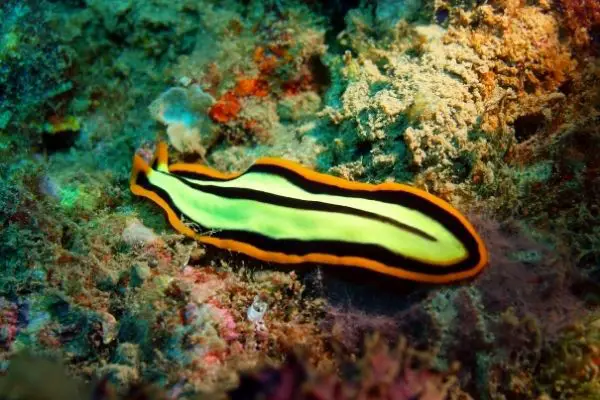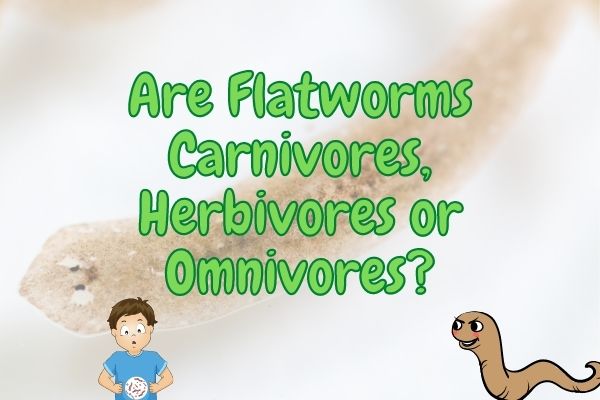Flatworms are the types of worms that belong to the Phylum Platyhelminthes. A commonly known flatworm is a tapeworm. They are small, slimy creatures with a flat body that can be found in a variety of habitats all over the world. While they may not look like much, flatworms play an important role in the food web as omnivores and secondary consumers.
Flatworms are opportunistic feeders that will feed on other small creatures and organisms. Therefore, most species of flatworms are considered omnivores, but some species are purely herbivorous or carnivorous.
Some marine flatworms are true omnivores and will eat algae, bacteria, protozoans, eggs, and larvae and other small aquatic organisms.
Others are carnivores and can also feed on snails, clams and other worms, but also human tissue.
However, as parasites and scavengers, they may infect and find shelter in large organisms like organs in humans. The tapeworm and fluke worm are examples of parasitic flatworms. They can infect their host and derive nutrition from them.
Very few flatworms are herbivores and these eat mostly algae and detritus.
Flatworms are very diverse and are found on all continents except Antarctica. They are generally placed in the Platyhelminthes, a group of animals that includes the parasitic roundworms and flukes.
They are found in both marine and freshwater environments, are generally less than an inch in length, and are usually flat in body shape. Flatworms are very simple organisms with a “flat” body (hence the name).
Their flat body allows them to reach otherwise inaccessible places like the inside of animals! They may even crawl through the opening of a closed mussel, clam, or oyster!
Although they have no true internal organs, their bodies do have tiny structures called phasmids that sense light, gravity, and touch. They lack a circulatory system but have an excretory system. In freshwater flatworms, the excretory structure is known as Malpighian tubules.
As a group, flatworms are very diverse, with about 17,000 species. The flatworms are more diverse than the roundworms and have a larger species number.
Flatworms are classified as Chromadorea (“colouring animals”) and represent one of two major lineages within the Platyhelminthes.
They may live as parasites (as do many roundworms) or as free-living predators or herbivores (some will even eat other flatworms).
As predators, they generally eat small invertebrates, including other worms, bacteria and protists.
Contents
Why are flatworms important for ecosystems?
Flatworms are important in the ecosystem because they are omnivores, which means they eat both plants and animals. This makes them secondary consumers in a typical food chain. They help to keep the population of primary consumers in check, and they also provide food for other predators.
Flatworms are also important because they help to decompose dead plants and animals. This process is important for recycling nutrients back into the soil so that new plants can grow. Without flatworms, there would be a build-up of dead matter, which would eventually lead to a decrease in plant growth and an overall decrease in biodiversity.
While flatworms are not true decomposers, they do play a role in breaking down organic matter. Their digestive system is home to bacteria and fungi that help to break down the food that the flatworm eats. Without these microorganisms, the flatworm would not be able to digest its food properly.
Parasitic flatworms thrive on or inside the body of their hosts where they get shelter and nutrition. In the process, it causes harm to the host. They are a common parasite to humans.
Are Flatworms Carnivores, Herbivores or Omnivores?
Flatworms are omnivores because they eat both plant and animal-based materials. Very few are herbivores because they do not solely depend on plants for nutrition.
Most flatworms are carnivores because they solely depend on animals for nutrition.

However, many flatforms can eat both plant and animal matter so they are omnivores.
Herbivores are organisms that depend solely on producers like plants for nutrition so flatforms cannot be termed as herbivores. their eating habits are of herbivores as well as carnivores so, as a group, they are omnivores.
Are Flatworms Producers, Consumers or Decomposers?
Flatworms are consumers because they eat other living organisms. Being omnivores, which means they eat both plants and animals.
They are not producers because they can not prepare their own food and depend on other organisms for nutrition and energy.
What Type of Consumer is a Flatworm?
In a typical food chain, flatworms are secondary consumers because, like all other omnivores, they consume both plants and animals.
Generally, herbivores are primary consumers, omnivores are secondary consumers and carnivores are tertiary consumers.
Can Flatworms be Considered Decomposers?
No, flatworms are not decomposers. They eat other living things, but they are definitely not decomposers.
Where are Flatworms in the Food Chain?
Flatworms are secondary consumers because they eat both plants and animals. They feed mostly on plants, but may also feed on animals.
So, they mostly function as secondary and tertiary consumers in a food chain.
Are Flatworms Autotrophs or Heterotrophs?
Flatworms are heterotrophs because they eat other living organisms. As heterotrophs are organisms that depend on other organisms for food.
Practically no animals classify as autotrophs because animals do not get their energy directly from the sun and can not prepare their own food as plants do.
That is, animals like the flatworms cannot make their own chemical energy, but need to eat other organisms to derive energy and a carbon source.
Some snails, however, at so many algae that they themselves can perform photosynthesis!
What Animals Prey on Flatworms?
Flatworms are food for a variety of animals including fish like Angelfish and wrasses. But also other animals like beetles and larger worms.
Conclusion
In this blog post, I have looked into the eating preferences and ecology of flatworms and the importance of their role in the food chain.
Flatworms are a group of invertebrates that belong to the phylum Platyhelminthes. They are heterotrophs and can often be found as parasites.
They play an important role in the food chain because they are predators and prey for many other creatures. They mostly classify as secondary consumers in a food chain.
Flatworms are an interesting group of organisms as their body is flat and they lack a body cavity.
Also, they are important in our own lives because we often use them in teaching science and biology to children!




